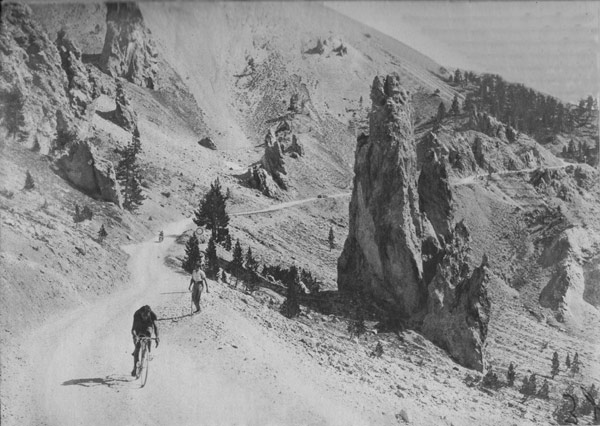On the desert-like descent of the Col d’Izoard during the 15th stage of the 1939 Tour de France, Sylvère Maes dramatically turned the tide of the race. Heading into the stage, René Vietto, the French favorite, was leading the general classification, but the rugged and barren landscape of the Izoard would become the backdrop for Maes’ decisive move.
As the peloton began its ascent of the Col d’Izoard, Maes seized the moment to launch a powerful attack. The Belgian rider, who had been lying in wait, chose this critical juncture to make his move. The Izoard, with its steep and uneven terrain, is a climb that can expose even the most minor weaknesses in a rider’s form, and Vietto found himself unable to respond to Maes’ surge. Despite his reputation as one of the best climbers of his generation, Vietto was left behind as Maes steadily gained time on his rivals. The brutal ascent took a toll on Vietto, who, despite his best efforts, struggled to maintain contact with Maes.

Maes’ strategy on this stage demonstrated not only his physical strength but also his tactical acumen. The Col d’Izoard, particularly its most iconic section, the “Casse Déserte,” is a unique and intimidating challenge. This area, marked by its rocky and barren landscape, offers little relief to riders, and the lack of vegetation and shelter makes it especially difficult for anyone attempting to chase down a breakaway. As Maes continued to push the pace, the gap between himself and the rest of the peloton widened. The relentless nature of the climb, combined with Maes’ superior conditioning and well-timed effort, made it increasingly clear that the stage was slipping away from Vietto and the other contenders.
Reaching the summit of the Col d’Izoard was only half the battle for Maes.
The descent that followed, while equally challenging in its own right, provided the Belgian rider with the opportunity to extend his advantage.
The descent from the Izoard is notorious for its sharp turns, loose gravel, and sheer drops, requiring not only technical skill but also significant mental fortitude. Maes, known for his strong descending abilities, navigated these treacherous slopes with confidence and precision, further distancing himself from his competitors. The barren, rocky terrain that characterizes the Izoard’s descent added to the difficulty, yet Maes handled the conditions with the poise and control that would ultimately secure his lead.
Meanwhile, Vietto’s struggles continued. The physical effort required to stay in contention during the ascent had clearly taken a toll on the Frenchman, and his inability to recover during the descent meant that Maës’ lead only grew larger. As the stage progressed towards its conclusion in Digne, it became evident that Vietto’s hopes of defending his lead in the general classification were fading. Maes, conversely, appeared to grow stronger as the stage went on, and by the time he crossed the finish line, he had succeeded in not only winning the stage but also in seizing control of the yellow jersey.
This stage marked a turning point in the 1939 Tour de France, as
Maes had effectively overturned Vietto’s lead in the general classification.
The magnitude of Maes’ performance on the Col d’Izoard cannot be overstated. His calculated attack on the climb, followed by a masterful descent, demonstrated a level of skill and endurance that his rivals could not match. While Vietto had been the early favorite to win the Tour, the events of Stage 15 made it clear that Maes was now the rider to beat. Having claimed the yellow jersey, Maes would go on to defend his lead throughout the remainder of the race, ultimately securing his second Tour de France victory.
For René Vietto, the outcome of this stage was a bitter disappointment. Despite his strong showing in the early stages of the race, his inability to respond to Maes’ attack on the Izoard marked the end of his hopes for overall victory. Vietto’s struggles on the Izoard highlighted the fine margins that often define the Tour de France; even a rider as talented and experienced as Vietto could not overcome the challenge posed by the formidable Maes. Vietto would continue to fight in the subsequent stages, but the damage done during the 16th stage proved insurmountable.
The significance of Maes’ triumph on the Col d’Izoard extended beyond the 1939 Tour itself. This was the last edition of the Tour de France before the outbreak of World War II, and the race would not be held again until 1947. As such,
Maes’ victory became one of the defining moments of pre-war cycling history.
His ability to navigate the complexities of the Tour, both in terms of physical endurance and strategic planning, ensured that his name would be remembered alongside the greatest champions of the sport. The 1939 Tour, with its dramatic battles on the mountains and the shifting fortunes of its leading riders, would go down in history as a race defined by Maes’ dominance.
The Col d’Izoard itself would also continue to play a key role in the Tour de France in the years that followed. Its status as one of the most iconic climbs in the race was solidified by performances such as Maes’ in 1939, and it has since become a staple of the race’s most challenging mountain stages. The unique and punishing nature of the Izoard, with its unforgiving gradients and the harsh, desert-like landscape of the “Casse Déserte,” has made it a legendary part of the Tour’s history. Riders who aspire to overall victory must often prove themselves on the Izoard, much as Maes did in 1939.